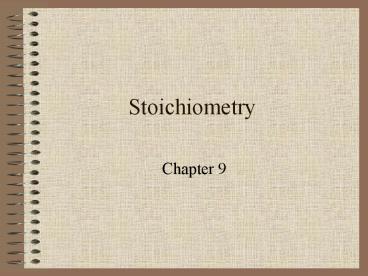Stoichiometry - PowerPoint PPT Presentation
1 / 23
Title:
Stoichiometry
Description:
Composition Stoichiometry: relationships that describe what an element is made up of. ... Reaction Stoichiometry: using the relationships between compounds (Ex: ... – PowerPoint PPT presentation
Number of Views:314
Avg rating:3.0/5.0
Title: Stoichiometry
1
Stoichiometry
- Chapter 9
2
Totally Up Front
3
Theoretical Yield
- What does the word yield mean? Theoretical?
- This is how much stuff you should get on the
products side. - What factors would make it so you dont get all
that you should? - Human error, changing containers, etc
4
Some Math
- If you have 12 g of C, how many moles do you
have? - If you have 24 g of C, how many moles do you
have? - If you have 36 g of C, how many moles do you
have? - If you have 48 g of CO2, how many moles do you
have?
5
Moles
- Convert 10 g of H2O to moles.
- How many grams of H2O do you have if you have 6
moles? - If you have 100 g of C6H12O6, how many moles do
you have? - If you have 3.456 moles of C6H12O6, how many
grams do you have?
6
CH4 2O2 ? CO2 2H2O
- If you have 16.04 g of methane, in excess oxygen,
what mass of oxygen is used in the equation? - How many moles of methane do you have?
- What is the ratio of moles of methane to moles of
oxygen? - How many moles of oxygen are used?
- How many grams is that?
7
Theoretical Yield
- If 10.0 g of C is combined with excess oxygen to
get carbon dioxide, what mass of CO2 in grams is
isolated? - Write the equation.
- How many moles of C do you have?
- How many moles of CO2 does that make?
- How many grams is that?
8
Fe2O3 3CO ? 2Fe 3CO2
- What is the maximum mass of iron, in grams, that
can be obtained from 454 g of Iron (III) Oxide? - What mass of CO is needed to reduce iron(III)
oxide to iron metal? - This is stoichiometry at its best!!! (Having fun
yet?)
9
4Al 3O2 ? 2Al2O3
- If you have 6 moles of Al, how many grams of
Al2O3 is produced? - If you have 300 g of oxygen, how much Al are you
using?
10
Do practice worksheet!
11
Moles Aforethought
12
CaO 2NH4Cl ? 2NH3 H2O CaCl2
- If exactly 100.0 g of ammonia is isolated , but
the theoretical yield is 136 g, what is the
percent yield? - If I use 86 g of ammonium chloride are used and
13 g of water are made, what is my percent yield?
13
Zn Cl2 ? ZnCl2
- What is the percent yield if 65.2 g of ZnCl2 is
isolated from 35.5 g of Zn? - 87.9
14
2NaBH4 I2 ? B2H6 2NaI H2
- Suppose 1.203 g of NaBH4 and excess iodine is
used and you isolate 0.295 g of B2H6. What is the
percent yield? - 67.2
15
HCl NaOH ?H2O NaCl
- Suppose you have 40 g of HCl and 60 g of NaOH.
How much NaCl will you make? - Must find the limiting reagent!!
- Before you can solve for NaCl, find out if HCl or
NaOH limits the reaction. Which one is in excess?
16
CO H2 ? CH3OH
- If you have 152.5 kg of CO and 24.5 kg of H2, how
many grams of CH3OH can be produced? - 174.5 kg
17
Fe2O3 CO ? Fe CO2
- If you have 18.0 g of iron (III) oxide and 110 g
of carbon monoxide, how many grams of iron could
you make? - 125.9 g
18
Some Vocabulary
- Composition Stoichiometry relationships that
describe what an element is made up of. (Ex
calculating molar mass) - Reaction Stoichiometry using the relationships
between compounds (Ex Using the mole ratio)
19
Jumpin Jack Flash, Its Glass, Glass, Glass!
20
Stoichiometry in Use
- Combustion of Octane in car engines
- C8H18 25O2 ?16CO218H2O 10900kJ
- What are the two reactants here?
- How are they controlled?
21
Carburetor
- Your engine has three modes of combustion, normal
speeds, starting, and idling. - See page 298
- Normal speeds octane is the limiting reagent
- Starting and idling, oxygen is the limiting
reagent - Flooding!
22
Pollution
- What else comes out of your gas tank?
- Hydrocarbons, CO, oxides of nitrogen
- Where do these come from?
- Incomplete combustion can allow octane fumes out
the back. - Lack of Oxygen can form CO2
- Nitrogen in the air forms oxides of Nitrogen
23
Acid Rain
- Oxides of Nitrogen can form with water in the air
to form acids. - Cars use a catalytic converter to convert NO2 ?
NO O - That O is not stable and can help form O3, which
near the earth can cause smog as well































